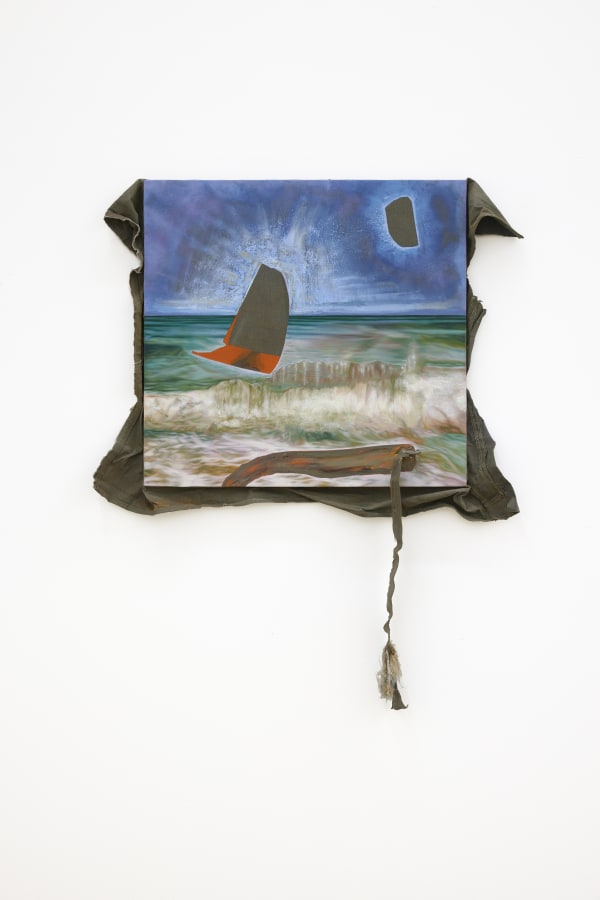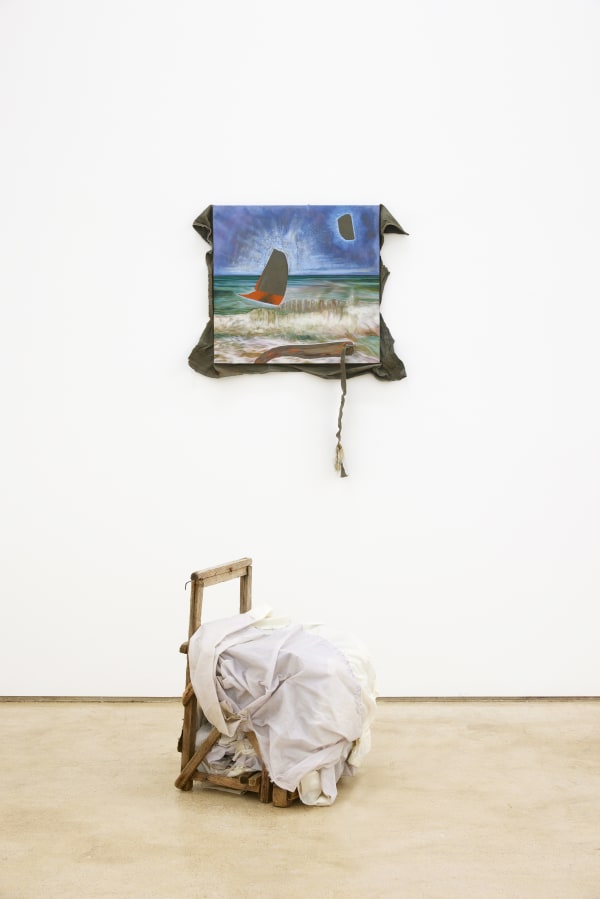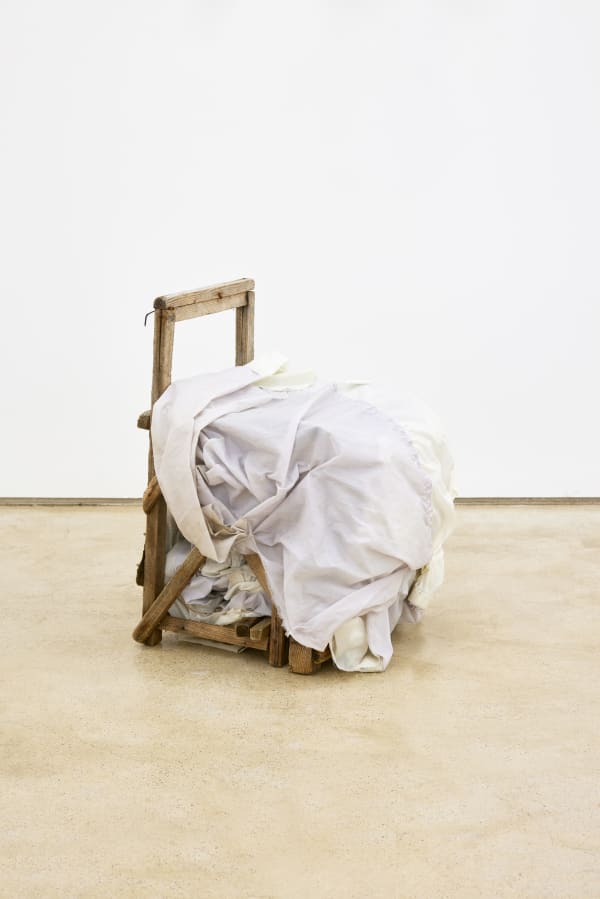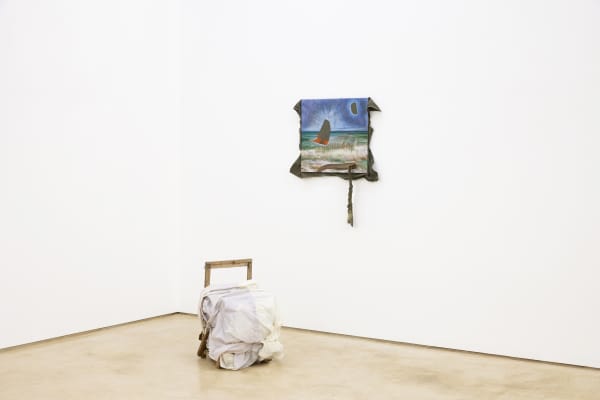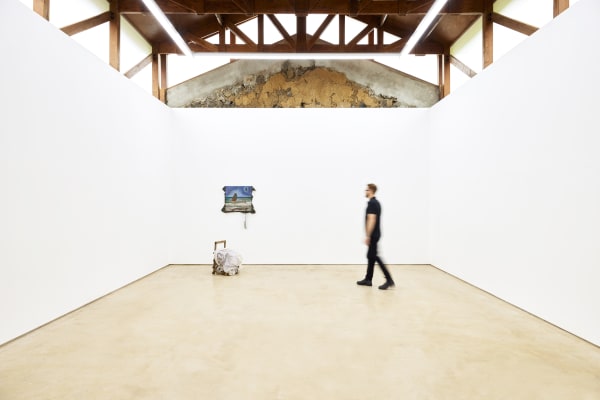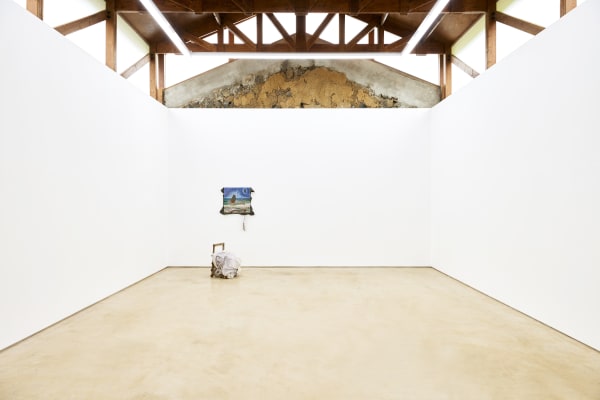RETURN: 진 마이어슨 Jin Meyerson
그 곳에서 저 곳으로. 그리고 다시 그 곳까지:
실제와 가상이 공존하는 현실과 상상의 공간. 두 오브제 사이에는 상실, 회복, 근절과 전시라는 접점이 잔잔한 대화를 매개한다. 진 마이어슨(Jin Meyerson)의 설치작 〈시퀀스 2〉(2021)는 그림과 의자, 둘로 구성되었다. 벽에는 바다 풍경을 그린 작은 회화가 걸려있다. 거칠게 일렁이는 파도의 투박한 그림이지만 물성의 파열을 담고 있는데 캔버스는 찢어진 표피처럼, 그리스 신화의 반인반수 정령 마르시아스의 찢어진 피부처럼 벗겨져 있다. 낡아 보이는 이 회화는 북한의 난파된 ‘유령선’에 걸려있던 것이 파도에 휩쓸려 일본의 사도섬으로 떠내려가 재발견된 물건이다. 이 파도 그림 앞에는 낡은 나무 의자가 하나가 있고, 그 좌석 위아래로 해묘 또는 물풍(물돛)이 구겨져 있다. 이 역시 사도섬에서 회수한 물건이다.
고요한 전시 공간의 분위기는 상실과 그리움, 버려짐과 갈망이라는 이분법적 암시로 가득하다. 작가는 무엇인가 결여된 일상의 오브제를 병치하여 호기심과 시적인 로망을 불러일으킨다. 병치된 오브제 간의 운치 있는 담화는 날카롭고 심오하여 깊은 곳을 도려낸다. ‘파열’의 이해관계와 문제점을 깊이 도려내는 예리한 날이다. 그의 작품은 이념과 전쟁으로 인해 반으로 나뉜 오늘의 한국과 맞닿아 있고 탈식민지 시대에도 여전히 정치적인 이유로 역사의 진실과 그 소유권에 대해 중언부언하는 일본과 닿아 있으며, 무엇보다 작가 자신에 대한 이야기가 담겨있다.
고아였던 작가는 5살 때 미국인 부부에게 입양되어 미국으로 이주했고, 작가가 된 그는 최근 한국으로 발길을 돌렸다. 이번 설치 작품은 시간과 공간, 형태와 기능, 재료와 기억이 얽힌 파동을 진솔하게 자아낸다. 발인과 부활의 의미를 동시에 내포하는 이 작품은 줄거리가 모호하고 흐름이 장황한 이야기로 방문객을 어둡고 비밀스러운 곳으로 안내하는 한편, 그 외의 가능성들은 모두 닫아버리는데, 그 이면에는 우연의 변덕이 숨어 있다. 작가에게 우연이란 없다. 특히, 그의 작업 방식은 미지의 사건, 주인공 등의 줄거리는 시간이 흐름에 따라 결국 공유된 경험과 의미를 발현 시켜 우리가 세상을 바라보는 시선을 바꾼다.
이 소개 글은 영국 윌트셔 카운티[1]의 작은 마을 샌디 레인에 위치한 필자의 서재에서 썼다. 이곳에서 제주도 한라산 가장자리에 위치한 갤러리2의 아름다운 감귤 과수원까지의 거리를 대략 측정하니 약 9,385km다. 한국과 영국 사이, 지구본을 가로지르는 거리도 있지만, 사람과 사람, 순간과 순간의 거리도 있을 터이다. 그러니 작가와 그의 작품을 향한 필자의 교감은 귀할 수밖에 없다. 아쉽게도 전 세계는 코로나바이러스로 작가의 〈시퀀스 2〉를 실제로 방문하여 볼 수 없었지만, 이 물리적 거리감으로 인해 마이어슨의 두 오브제를 더욱 깊이 바라보고 쳐다보며 찢기고 갈라지고 뚫린 구멍으로부터 더욱 증폭된 불안감을 만끽할 수 있었다. 필자가 여러 번 방문하고 추억을 쌓은 한국이지만 지금은 국가 간의 이동이 자유롭지 못하다. 국가 간의 거리가 벌어진, 교류가 정적인 상태라고 할 수 있다. 성장하여 예술가가 되기까지 ‘이곳’ 사람이 아니지만, 딱히 ‘저곳’ 사람도 아닌 자기 자신의 지워진 (혹은 불투명해진) 과거를 납득하고 앞으로 나아갈 미래를 추구하는 기억의 틈과 정체성의 틈, 이는 작가의 현재와 불분명한 과거가 맞물리는 곳이다.
그런 맥락에서 작가가 오브제의 상태를 해석하는 방식은 여러모로 기발하다. 그는 Duchampian, Johnsian, 심지어 Joycean의 텍스트-컨텍스트 전략으로 오브제에 접근한다. 형상과 지표에서 발견하는 의식의 흐름은 작가 개인의 정체성에 대한 긍정이자 일종의 교리문답의 역할을 수행한다. 작가가 〈시퀀스 2〉를 전시하는데 채택한 복합적인 접근법도 하나의 실마리다. 설치작이 주체(subject)와 대상(object), 그리고 그 경계를 위협하는 주체도 대상도 아닌 비체(卑體, abject)의 관계 내에서 동요하듯이 물리적 설치의 결과 또한 다양한 위상의 변화를 야기한다. 이러한 변화는 구상 속 추진, 감정적 논쟁, 가상의 전시, 디지털 수치, 공개 강연, 그리고 그저 개인적 항의의 순간일 뿐이다. 설치는 유·무형의 다양한 위상으로 존재하며 다층적인 경험을 제시하는데 여기서 작품에 빼놓을 수 없는 ‘자기본위'적 (불협)화음을 말끔히 소화해낸다. 작가는 지난 수년간 사회를 이루는 다양한 개인적, 집단적 정체성을 분별하고 실마리를 풀어내는데 작업의 초점을 맞춰왔다. 정체성이라는 난감한 주제를 좌우 대칭의 잉크 얼룩이 있는 카드로 이루어진 로르샤흐(Rorschach) 인격진단검사처럼 사용하여 관객이 패턴과 리듬, 결합점을 읽어내도록 한 것이다. 얄궂게도 작가의 설치작은 무명의 쓰라림과 동시에 정신없는 삶의 활력이 공존하는 설치물이 되었다. 빛바랜 무지 위에 만질만질하게 광택을 덧칠한 작가의 이번 작품은 기존 작품과 같이 유대감에 대한 갈망이라는 맥이 흐른다. 그 맥박을 짚고 관람객 개개인이 계시와 화합의 빛으로 천천히 그리고 부드럽게 들어갈 수 있도록 이끈다.
〈시퀀스 2〉는 일종의 동시대적 부적이다. 오브제, 공간, 아이디어, 그리고 폭로는 수많은 진실을 갖고 있다. 그중 하나는 지난 1년 남짓 되는 기간 동안 사랑하는 이들과 가까이할 수 없었던 분리와 격리의 방역 수칙에 대한 집단 동요를 다루고, 또 다른 진실은 국가적 논쟁이 짙은 과거가 있으며, 한때 손실되었으나 되찾은 특정 오브제의 진실이 있다. 다만 이번 설치작은 작가 자신의 진실에 대한 자체적인 탐구 활동을 상징한다. 잠시 잃었으나 지금은 되찾았거나 혹은 용서를 받았다. 〈시퀀스 2〉는 작가 자신도 알 수 없는 과거를 향한 서신으로, 지금도 남아있는 기억의 파편, 갈망, 그리고 신념을 모자이크식 세공 패턴으로 엮어낸다. 자신을 이해하고자 하는 의지는 이번 전시처럼 장소와 공간, 시간을 가로지르며, 현실이고 가상이며 회고하고 허구의 것이다. 격리와 전위(轉位)로부터 작가와 관객을 되찾고 새로운 대화의 장을 개최하고자 한다. 결국에는 치유의 순환이 새로 시작되는 것이다.
맷 케리-윌리엄즈 Matt Carey-Williams
샌디 레인, 윌트셔, 영국
2021년 3월
* 필자는 런던 빅토리아 미로(Victoria Miro) 갤러리의 시니어 디렉터로 활동 중이다
[1] 샌디 레인(Sandy Lane), 런던 중심부에서 서향으로 약 150km 거리, 영국 남서부의 항구도시 브리스톨 (Bristol) 동향으로 40km 거리에 위치.
From There to There and Back Again:
Sentences of Sequestration and Circuits of Conciliation
in Jin Meyerson’s Sequence 2
In a space, both real and imagined; both ambient and virtual, a hushed conversation takes place between two objects. Both found. Both lost. Both displayed. Both displaced. Jin Meyerson’s installation, Sequence 2 (2021), is made up of two elements. On the wall hangs a small painting of a seascape. The boisterous maelstrom of its crudely executed waves echoes its ruptured physicality, with the canvas ripped open, dangling from the support like Marsyas’ flayed hide. The distressed condition of the painting is a result of it having been lost at sea, surrendered to the elements by a North Korean ‘ghost ship’ and subsequently washed ashore on the Japanese island of Sado where it was retrieved. Sitting quietly next to the painting is a chair: a rickety, rudimentary piece of furniture swaddled in a Japanese fishing parachute which, again, was reclaimed from the same Japanese island beach as the painting.
The still air is here perfumed with binary intimations of loss and longing; of abandonment and belonging. The somewhat jejune state of these pedestrian objects fuels their curiosity and poesy when seen in juxtaposition. Yet the animus of the dialogue between these two queer and quaint objects remains profound and cuts to the quick. It’s a dialogue that delves deep into the problematics and politics of rupture. It touches on the schism of a modern Korea, bifurcated by war. It points to a post-colonial Japan, still engaged politically in an epistemological vibration between the facts of history and the flux of historiography. Of truth and who owns it.
It speaks to the artist himself who, when just five years old, as an orphan, was adopted by an American couple, moving to America and raised there and who, recently, returned to his homeland. This is a candid installation that reverberates in entangled ellipses of time and place, form and function, material and memory. Both a burial and a baptism, it operates as a litany of seemingly random junctures whose phenomena open secret doors to dark confessions whilst shutting others tight, behind which lies the caprice of coincidence. For Meyerson, chance does not exist. There are only unknown events, protagonists or narratives that, as time hurtles through space, eventually manifest into sequences of shared experience and collective meaning that can – and do, very much so for this artist – shape the way we see the world around us.
I am writing this introduction from my home in a tiny village in England called Sandy Lane in the county of Wiltshire. By my rough calculations I am about 9,385 kilometres from the beautiful mandarin orchards of Gallery 2, nestled on the edge of Hallasan Mountain on the island of Jeju. That’s a lot of distance between two places; two people; two moments. Yet my connection to the artist and his work remains dear. My segregation from Sequence 2 is, of course, forced upon me by the Coronavirus pandemic which, still, runs riot across our planet. So it is that this physical separation amplifies even further the anxiety of estrangement I feel pouring through every rip, tear, crack and puncture of Meyerson’s two objects. Fissures between nations; between my own memories of my numerous visits to Korea and the stasis we all currently experience. The gaps of memory and identity of a tiny boy then and an adult artist now - not from here, not from there - with a past if not erased then certainly obscured, yet from somewhere, who became determined to understand and forge the direction of his future. One that dovetails with both his present and his nebulous, indistinct past.
In many ways, then, Meyerson’s clever interrogation of the status of the object, filtered through various Duchampian, Johnsian or even Joycean strategies of text and context; of Image and Index chimes with a stream of consciousness that acts both as an affirmation and catechism of personal identity. The plurality of means adopted by the artist when presenting Sequence 2 is also telling. Just as this installation zips between the trinity of object, subject and abject, so too does it morph between its consequence as physical installation; conceptual thrust; charged polemic; virtual exhibition; digital display; public lecture and, simply, a moment of personal protest. The installation can – and does – exist in various states, both tangible and intangible, offering (in fact demanding) a multi-lamination of experience which, in so many ways, neatly articulates the dissonance and assonance of selfhood that is so crucial to Meyerson’s art. For years his practice has attempted to unravel society’s various threads of entangled identity – collective and personal - as a kind of Rorschach of intractability, marshalled by a geometry in his painting that seeks pattern, rhythm and nexus. So it is that here he has created an installation that, ironically, feels almost weighed down by anonymity yet fizzes with the abstracted life of history. The matte of the unknown supplanted by the gloss of celebration. Just as with his paintings, its pulse is propelled by a desire for association. That condensation of collated sensation that cautions us individually to go gentle and slowly into this new, hopeful light of revelation and reconciliation.
In the final analysis, Meyerson’s Sequence 2 is a kind of phylactery for our times. An object, space, idea and divulgence that keeps safe numerous truths. The truth of our collective disquiet at having been locked down for the best part of a year during this pandemic, separated from those we love. The truth of a past, bristling with national contention. The truth of an object, once lost, but now found. Ultimately, however, this installation represents Meyerson’s quest for his own personal truth. Once lost, but perhaps, now found. And if not found, then forgiven. Sequence 2 is his epistle to a past he never knew, but which he, now, tries to tessellate together with fragments of memory, desire and self-belief. That drive for self-understanding, like this installation, flows through place, space and time. It is real, virtual, remembered, invented. It attempts to wrest the artist – and his viewer – from the bondage of sequestration and dislocation and usher in a new chapter of dialogue and, at the end of the day, a new cycle of healing.
Matt Carey-Williams
Instagram: @matt_careywilliams
Sandy Lane, Wiltshire
March 2021
Matt Carey-Williams is Senior Director and Head of Sales for Victoria Miro Gallery in London.
